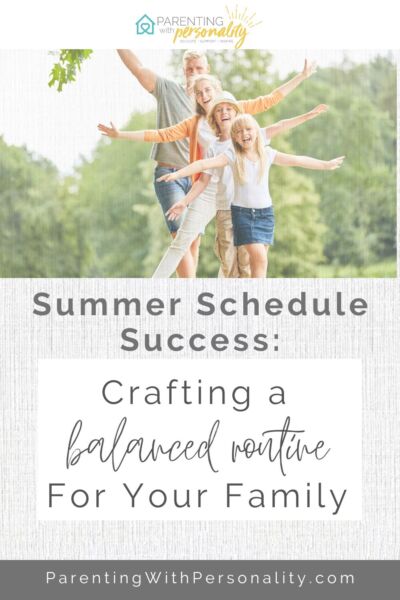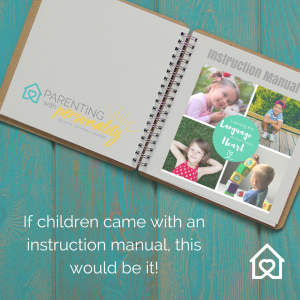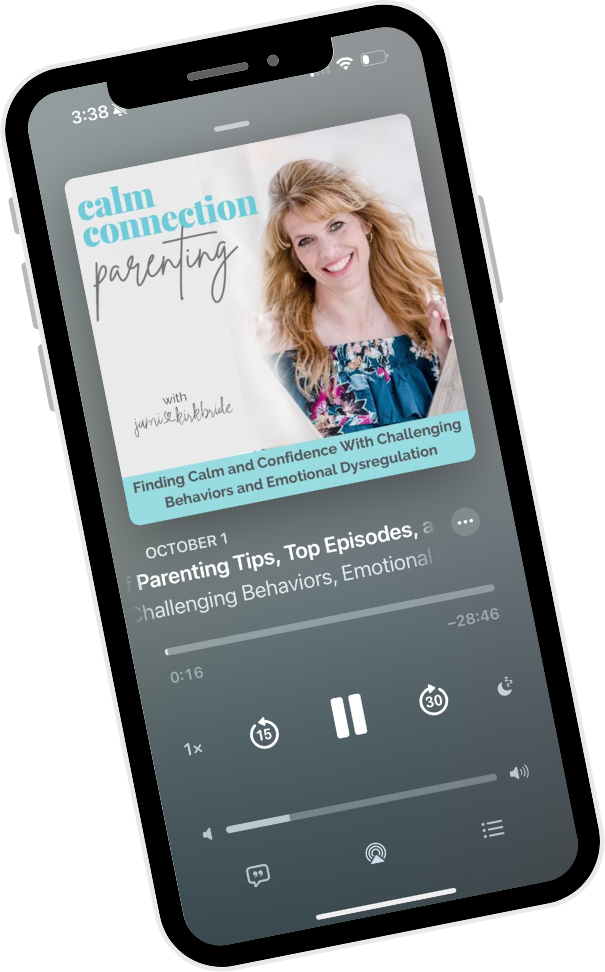
Are you looking for a happy and harmonious summer break with your child? Discover the secrets with this expert guide on creating a balanced daily summer routine for your family. Explore the benefits of structured schedules and involve your child in the process. Learn effective strategies to manage the many transitions smoothly, while promoting social-emotional well-being. Find the perfect blend of structure and free time that your child and family need to create life-long memories while maintaining work-life balance as well. You can unlock the key to a successful and exciting summer with these tips and tools! Enhance your family’s summer experience.

The Importance of a Structured Summer Schedule
The Journal of Child and Family Studies did a study that found children who follow a consistent and balanced summer routine experienced lower levels of stress and anxiety. It showed that having a predictable schedule and engaging in regular activities helped children feel more secure, reducing symptoms associated with anxiety. Likewise, research conducted by the American Academy of Pediatrics, relayed that a structured summer routine can significantly decrease behavioral difficulties in children. Consistent routines provide children with a sense of stability and predictability, which is helpful in reducing behavioral challenges and promoting self-regulation.
But it’s not just the youngest children that are benefiting. You might also be interested in knowing that a longitudinal study published in the Journal of Early Adolescence found that children who follow a balanced summer routine have better emotional regulation skills. Consistent routines are revealed to provide children a sense of control and enable them to better manage their emotions, leading to decreased stress levels and improved overall mental health.

Benefits of a Summer Schedule
There are many benefits to having a structured summer schedule, but these three are the ones we will focus on here:
- Routine Stability–Helps children maintain a sense of stability through routine which is important for their overall well-being. Schedules that are consistent provide a sense of predictability as well as security, which reduces anxiety and promotes an order to daily life.
- Time Management–Allows families to manage time effectively, taking time for the important or prioritized activities and responsibilities (for work, home, household, quality time together) while preventing overwhelm and chaos.
- Growth and Skill Development–Provides opportunities for children to take part in various activities that promote their social skill development and personal growth, while offering time to engage in things both structured (educational, team or sports) and unstructured play time (imaginative play, creativity,and independence).

Setting the Foundation
Identify Your Family’s Goals–Designing a Summer Routine for Success
Each family has their own idea of how summer should look, feel, and be enjoyed. Likewise, each child can have differing opinions as well. So it can make setting the foundation a bit of a challenge. This is why my first piece of advice is to have a family huddle, yes, just like a team would do, going into a big game! And talk about your game plan. You might just take some time brainstorming what people are hoping for, looking forward to, planning on, etc. You can also cover any concerns or worries.
Considering Individual Children’s Needs–Crafting a Customized Schedule
It won’t take long to realize that your children have different ideas of fun, summer, and enjoyable! But that’s okay. You can take time individually with each one if it makes it easier and then come back together to talk through a “together plan” once you have an individual understanding. Some children who are more energetic will desire staying busy and active. Children who are more introverted wouldn’t mind a summer full of home days and quiet. Children with many sensory needs may have a lot of special accommodations that need to be understood or adjusted for. And those with mental health issues may need to schedule in that time to keep them in good order with their anxiety, depression, or other needs. One size won’t necessarily fit all, so try to make a plan that factors in your child’s individual needs.

Factors to Consider for A Summer Schedule– A Guide for Parents
Designing the Daily Routine
From the moment the first child’s eyes pop open (or yours) if you are the early riser, it might feel like you have to be “on!” But I encourage you to look at summer with a little more ease. There will be moments things feel a bit stressed or tense, and there will also be those times that you can sit back and relax a bit. It will be important that you find time for both. No summer routine should bring out the worst in you or your child. And if it is…change it! Summer is your time to enjoy your time together with maybe, fewer demands than the school year entails. Make sure you set yourself up for success.
Many parents feel conflicted in balancing all the important aspects of summer for growth and development. And undoubtedly, your children will have differing views on what the right balance of these might look like. While there are some obvious personality differences, there will probably also be some age, unique wiring, special needs, and issues that need to be considered. Prepare yourself that you and your child might have differing opinions on this as well. Think through each of these areas and be intentional in finding the balance your family needs in each of these this summer.
- Structured Activities vs. Free Play–Striking the Right Balance
- Educational vs. Enriching Activities–Summer Learning and Fun
- Relaxation vs. Downtime– Nurturing Well-Being in Your Family
- Screen Time vs. Outdoor Activities– Finding the Perfect Mix

Here are some quick tips to finding that right balance for your family:
- Divide the day into time blocks for both structured and free time. Ex: You might choose to have your mornings be more active for learning and going and doing, where your afternoons might be better for relaxing, quiet play, and games.
- Create a weekly schedule so your child can know in advance when you have those structured or routine activities or outings, but also that time and space that would be available for something more spontaneous if desired.
- Include children in choosing activities so they can be empowered by the decision-making process. Choosing these activities according to their interests and preferences fosters some additional ownership and excitement, allowing them a deeper buy-in to the plan.
- Mix some activities together so you can enhance learning with fun and movement. You may find that hands-on learning or educational field trips are a great way to fit in some fun summer learning on the go!
- Schedule in enough downtime since it is crucial for children to have some white space in their day too. They may choose to rest, relax, be creative or pursue some independent interest, but this unstructured quiet time allows them to enjoy some imaginative or self-directed play and learning as well as problem solving.
- Show flexibility and adaptability as it models for your child how to adjust with ease. There will be times that you need to adjust to be more spontaneous due to opportunities that arise, so be ready to change up the plans and embrace new ideas and experiences. Your child will learn a lot from watching you.
- Set realistic expectations. If you have a child who tires easily, plan for that. If you have a child who gets hangry at 11:45, eat earlier. If you have a child who exhibits challenging behavior when overstimulated with sensory input, choose your outings (places and times and people) with care. You child’s wiring may not be capable of doing what you expect. Make sure you are taking into consideration the supports that might be necessary.
- Make family time priority since so much of the year is devoted to school and the many activities we are required to be a part of…take time in the summer to schedule in family time. Aim for quality, not just quantity! Dedicate certain time slots for this special time.
- Encourage outdoor play as it allows children to engage in physical activity, get fresh air, explore nature, and get some healthy Vitamin D. Outdoor play also promotes mental well-being, creativity, and healthy physical development and habits.
- Emphasize consistent sleep routines even during the summer, since it is important for mental health and mood. Establish bedtime routines and ensure they are getting enough restful sleep to support their brain, body, and emotions.
By following these practical tips, you can create a summer schedule that combines all the activities in a balanced way, fostering growth and enjoyment for your children. Remember: it is important to tailor the schedule to your family’s specific needs and preferences.

Involving Children in the Process
Empowering Children: Let Them Shape Their Summer Routine
As mentioned, I encourage families to have a summer huddle to discuss their wishes, hopes, ideas, concerns, etc. In this huddle, I encourage you to allow your child to go first. Let them feel empowered as they express their ideas. I like to remind parents to keep a default setting of curious and wondering! Remember the first step is brainstorming. Too frequently shutting kids down with no’s or reasons things won’t work will hamper their ability to be creative, think outside the box, dream, and communicate. So work hard to understand and ask questions for more info due to interest! After they have shared their ideas, you can share yours. Keep the energy and enthusiasm, this is not the time to be a fun crusher or party pooper! LOL! Keep the positive ideas and attitude. It models that for them.
From Ideas to Action: Encourage Children’s Input and Engagement
Be sincere in trying to see things from your child’s perspective. It can make a huge difference in how you connect, brainstorm, or problem solve. Once children and parents have expressed their thoughts and feelings, it is time to put the ideas to action. How can you actively engage in planning a summer worth remembering? Don’t feel the weight of doing it all, providing it all, or buying it all! Summer can be simple and easy fun! This might be when you make those summer fun lists. This has been a tradition in our family since our youngest was in kindergarten. Each summer they list 10 things they would like to do. These aren’t big expensive things, just 10 things they’d really like to do. It might be an art project, playing in the sprinklers, eating at their favorite restaurant, picnicking in the park, going to see a certain friend…whatever it may be.
Why do we do that? Because it gives us a structure for what really matters to them. It helps us move from ideas to action. You may be surprised to find that things that they are really looking forward to doing are things that are much less time consuming or less expensive than what you feared! It’s a great starting point. We don’t guarantee that we will do it all, but we keep those lists handy and try to do what we can.

Flexibility and Adaptability: Adjust the Schedule Together
There may be some activities that you decide to do that you will need to plan for. There may also be activities that are not as easy to plan but can only be done more spontaneously, or when the time is right. Remember some personalities, highly sensitive, spirited, or otherwise uniquely wired children don’t flex and adjust well. It is very important that we show empathy and help these rigid thinkers with some support and understanding. Try to model the adaptability and willingness that you want to see in them. Help them learn to see things from differing perspectives by how you model that.
In fact, voice the inner dialogue that helps you work through these moments as a tool to help them learn to do the same for themselves. Practice this flexibility with even the little things so it comes better with the big things. If you find the schedule you make is working great, that is wonderful. But your child may need to know that you can always revisit the discussion again and make changes if needed. Schedules and lists and plans can overwhelm some kids, so having the safety that you can change it, if it isn’t working is very important for them.
Smooth Transitions and Minimizing Conflict
Switching activities, schedule changes, differing caregivers, evolving commitments, changing environments, drop-in visitors, summer vacations, and added expectations are just some of the summer transitions that can affect a child. Add to that a home environment that isn’t as structured as the school setting and where everyone is not necessarily doing the same thing (like in the classroom), and it can bring a host of challenging transitions into a child’s life!
Strategies for Seamlessly Transitioning
- Investigate if there are ways you can support and plan ahead for what might be needed for you and your child’s needs
- Hear your child’s feelings or thoughts about it
- Empathize with the challenge or feelings associated (sad, frustrated, angry, nervous, unsure, confused, mad, etc.)
- Adjust small things that might make it easier on them (see tools below)
- Respond with calm, clarity, and consistency so they know what to expect from you and the situation and that you can handle it
- Transform the trust, communication, and understanding between you and your child as you build your confidence in working through things together

Tools for Smooth Schedule Management
While transitions can often be a struggle for children, and especially those who are highly sensitive, highly emotional, intense, or challenging, it may be helpful to use visual, auditory, or timed reminders to help bridge the gap and ease the transition. You might find the following tools helpful in easing the transition between activities, environments, caregivers, and more:
- Visual Cues
- Visual Timers
- Reminders
- Graphics Schedule
- Individual Charts
- Calendars
- Checklist
- Family Huddle Form (template)
Making Transitions Fun and Engaging to Foster Cooperation
Knowing your child’s personality style can help you be more effective in engaging or motivating them. If your child is a fun-loving, excitable child, you may need to make a game of transitioning or the steps to make it happen. If your child functions best with details and a plan, you may need to talk ahead of time about how things will unfold and what you will do along the way. If your child is easily overwhelmed and worn out, you might need to keep the expectations low, and words minimal. And if your child works best with some control, you may need to offer choices to get them involved in the process with some level of healthy buy-in!
One of my favorite tools for transitions:
Depending on the amount of time your child or the situation might warrant, you can change this to fit. But let’s pretend you are at the park and you know you want to leave by 3:00. At 2:45, I’d encourage you to ask your child, “How much time do you need to get ready?” They will probably look at you and say, “I don’t know,” or a number of minutes. It will likely be less than 15. (Why? Because we don’t usually give them 20 minute warnings! LOL!) You can say would 5 or 10 minutes be enough or do you need more? At this point they may likely feel sad that 5 isn’t long enough. However when they say 10 or 15, you have that to give and no more. They are happy, and you can be happy. They are part of the plan, and I can almost assure you that they will have a much higher level of cooperation than if you had just said 5 minutes and expected them to stop.
This conversation is what I like to call prepping their brain. We are getting their thinking in place to start shifting the gears to start flexing and adjusting. It primes their brain to cooperate and adjust to the transition better!

Flexibility Within the Schedule
Embracing Spontaneity to Add Excitement to the Summer Routine
It is important to remember that a highly sensitive, highly emotional, intense, or challenging child will likely be triggered by many things. Some of the biggest triggers include the following:
- Being told no
- Change of routine
- Stopping a preferred activity
- Tasks or chores (demand)
- Changing what was already planned or expected
- Waiting for a turn or anticipated event
- When others change their minds or plans
Looking at this list, you can probably see how often these things happen over the course of summer. Part of that is that we live a much looser routine as a family than they often have in the classroom. And part of that is that it is an added feature of summer that there be a little more spontaneity without the demands of school schedules. So, you can probably appreciate how what is “supposed” to feel like a fun time can actually feel really stressful for a uniquely wired child! We can offer assurance, understanding, empathy, and small opportunities to help our children in this area.
Adaptability and Adjustments to Meet Changing Needs and Circumstances
Sometimes, our best systems and methods as moms fail us. Just ask me about the summer chore schedule from a few summers ago, that was shot to pieces on day one! Why?! Because I thought it would be a good idea to design it all myself and then present it! It felt easier, but let me tell you, I will never live that down. Mom moments gone wrong. I went about it all backwards. I didn’t involve them in the ideas and planning, and I didn’t allow much allowance for adjusting along the way. Build in the confidence with your child that you can make changes if needed but that you are going to try it for a designated time. Remember, it may be that your child needs supports or accommodations in place for some of the plans you make. Listen, and hear them well. It could be that their behavior is telling you, if the don’t quite have the words to articulate what they are struggling with!

Creating a Supportive Environment for Summer
You may be wondering, how can I create the environment my kids need this summer so we can be successful, enjoy our time together and make good memories. I get that! And I am intentional each summer to spend some time on that very thought, because it changes as our kids do! These might be some things to pay attention to to create that supportive environment for your summer:
- Consistency and Expectations–Are you establishing routines that work and are reasonable for your child? Do your expectations fit considering their unique needs and necessary supports, or do you need to adjust them a bit?
- Clear Communication and Guidelines–You can promote harmony in your family when you model calm, clear, considerate, and caring communication. Your ability to be consistent and show clarity will help build trust between you and your child.
- Nurturing Positivity and Connection–Are you building a happy summer atmosphere or are you worried, uptight, and stressed. Truly, the connection you foster will matter more than any money you spend on them this summer. Are you making good investments in their positivity and connection bank? Keep that in focus!
Promoting Work-Life Balance for Parents
The idea of kids being home for summer can create a myriad of feelings, some excitement, joy, thrill, anticipation, worry, overwhelm, anxiety, pressure, fear, dread, and for some even a little panic! And truth be known, it can be a mish-mash of all of that! Regardless of how much you love your child or love mothering, the change from school routine to summer break can feel stressful. Just know you aren’t alone!
Self-Care Strategies for Parents-Prioritize Your Well-Being
I remind parents often about the safety talk we get on airlines and how they tell us to put our oxygen mask on before trying to help our child with theirs. Parenting is the same. You need to take care of you, in order to take good care of them. An exhausted, overwhelmed, stressed parent can’t parent their best. It is never selfish to take time for self-care. It is a responsible way to manage the resources and energy that God gave you to be the best parent you could be for the child he hand-picked for you. And if you happen to be a parent who has a high need child…don’t feel one bit bad scheduling in some extra self-care. God knew you’d need that too!

Balancing Work and Family–Maximize Quality Time Together
One of the biggest challenges for some families and parents is just figuring out the balance between work and family. This will be different for each family. I encourage you to pray and think about what this looks like for you and your family. Is it different during the summer? Is it different during the school year? When is your best family time together? Haven’t found it yet….then it’s time! Make the most of your summers together. As an author friend of mine said once, “You only get 18 summers with them!” And then they’re on their way! So let’s use them wisely and purposefully!
Taking time to connect and play with your child early in the day may help you find the time you need later in the day to be productive or creative if you need to do some work. A little investment in their bucket, attention undivided, or caring interactions can help set you both up to accomplish the things you desire in a day without upset and frustration.
Indeed, there is power in a balanced summer schedule. It can truly help nurture you and your child in growth and happiness. So as you set out for summer break, I encourage you to craft your family’s summer routine so that it can be your blueprint for success. Taking the time to communicate, plan, and connect with your child this summer can help you not only embrace the joy of summer together but create meaningful lifelong memories together.
I’m excited to be sharing with you, for the first time ever… The Summer Synergy Challenge! This 30-day challenge is intended to help you and your child get off on the right foot this summer! This exciting, yet simple challenge gives you a short task to focus on each day. It will only take 15-20 minutes to do the task, but it can help build optimism, connection, gratitude, and growth. This will be an easy way to help you and your child grow a deeper and more meaningful connection. You won’t want to miss it! Follow this link to get the details and get your own 30-day guide! Hooray!
Article at a Glance:
- Learn the importance of a structured summer schedule for children’s well-being, emphasizing reduced stress and anxiety levels and improved emotional regulation skills.
- Understand the benefits of a summer schedule, including routine stability, effective time management, and opportunities for growth and skill development.
- Set the foundation for a successful summer routine by identifying your family’s goals and considering each child’s individual needs.
- Provide guidance on designing a daily routine that strikes the right balance between structured activities vs. free play, educational vs. enriching activities, and relaxation vs. downtime.
- Involve children in the process of creating the summer routine, empowering them to shape their own schedule, and engaging them through input and engagement.
- Smooth transition and minimize conflict with tools such as visual cues, timers, reminders, and family huddle forms. Making transitions fun and engaging for cooperation is also highlighted, taking into account different personality styles.
- Create a balanced and enjoyable summer routine that caters to your child and family’s specific needs and promotes well-being and growth of children.
XX

HURRY! :) Go JOIN the Summer Synergy Challenge and get your guide to summer success and connection…NOW! And join the Parenting With Personality Facebook Group where we will be talking about the challenge too!






